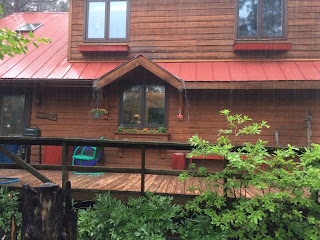Tree bark - Kate Crowley
GOING
NATURE’S WAY
We travel to see the
world anew. And we don’t have to travel all that far to be impressed by living
things we encounter. For the
Thanksgiving holiday we went to Iowa City where my mom lives, 375 miles south
of Willow River; best known as ‘Corn country’.
But while on a walk to the grocery store Mike and I paused to look at
two kinds of trees we don’t have here in North Central Minnesota; the shagbark
hickory and the plane tree (also known by some as the sycamore). Both of these trees have a very distinctive
and unusual type of bark covering their trunks.
We stopped and really looked at the texture and shape of the outermost
layer and speculated as to why it was this way.
Now that the deciduous
trees are bare, we can see their shape and structure; their ‘bones’ as it were.
All is revealed, including leftover little nests perched on the lower branches.
It is not an overstatement to say that the majority of people take trees for
granted. They stand there mute from
season to season and while we welcome their shady cover in the summer months,
we grumble when they drop their leaves onto our lawns each fall. Year after year, assuming disease or storms
do not interfere, they add inches to their height and girth and remain constant
in their presence; one of the few things in our lives that does so.
It is the bark I wish
to focus attention on today. As I said,
the shagbark hickory and plane trees have some of the most unusual looking bark
out there. As the name suggests, the shagbark
trunk has a greyish layer of long peeling pieces of bark that turn up at the
end, giving it a very shaggy appearance.
It is only the very mature trees (they can live to be 200) that have
this quality however. Young specimens
have a smooth bark.
The Plane tree has a
type of bark that peels off in irregularly shaped patches, giving the tree a
splotchy appearance. The older the trunk the more the bark thickens and cracks,
instead of flaking off. Underneath, the bark is smooth and either a chalk white
color or tan.
Back home I have been
looking more closely at the trees that grow around us and trying to see the
uniqueness of their bark. This layer of woody material encircling the tree’s
trunk and branches is its skin and much like our own outer covering, bark is
made up of two layers. The inner layer
is called bark cambium and consists of living cells that are constantly
dividing. These die if they are cut off
from water and sap. When they die they become the outer bark, which is the tree’s
main defense against weather and other potential hazards. New growth on the
inner layer pushes the previous year’s bark to the outside The thickness of
bark can vary enormously, ranging from as much as one foot thick (on a sequoia)
to just .5 inches on a beech tree.
Generally speaking, as a tree ages, the outer bark goes from a smooth
surface to one with many cracks and crevices.
Most trees here in the
north country hold tight to their bark until death, at which point insects,
fungi and general decay break the seal and pieces begin to fall off, or more
likely get peeled off by woodpeckers seeking the insects beneath. One exception to this rule is the birch
trees. Most of us are most familiar with
the paper birch, though we do have yellow and river birch in the state as well.
While the outer bark is
not thick on the paper birch it is extremely durable, as noted by the Native
Americans who made great use of this
resource – building canoes, shelters and cooking utensils with the bark. It is almost incomprehensible that the same
material used to start a campfire even when everything else is wet, can also be
set upon a fire while holding a liquid and NOT burn up. The bark peels naturally from the trunk, but
to take it from the tree in sheets must be done very carefully and only at certain
times of the year or the tree can be killed in the process.
I urge you to spend
some time looking at the trees around your home or in your neighborhood and see
the patterns and textures that make up their individual characters. Put your hands on them and feel the ridges,
the rough or smooth qualities. Maybe
even a better is to take a piece of paper and a dark colored crayon and make a
rubbing. This isn’t just a kid’s crafts;
it’s a way to learn more about some of the oldest and quietest neighbors you
have.





Comments
Post a Comment